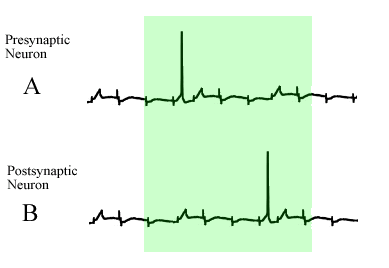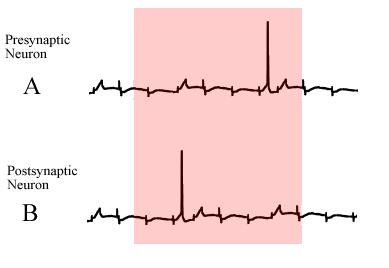

Thinking as a Hobby
3478580 Curiosities served
Learning With Spikes
Previous Entry :: Next Entry
Read/Post Comments (0)
This is an entry on a physiological mechanism by which synapses are modified by experience, in other words, how we learn stuff.
The technical name for what I'm talking about is spike-timing dependent plasticity (STDP), though it is also sometimes called temporally asymmetric Hebbian (TAH) learning. But despite the terminology, it's a relatively straightforward concept.
You may or may not know that neurons are specialized cells whose membranes act as tiny capacitors. This means that they hold an electrical charge, and when that charge exceeds a threshold, they generate an action potential, or spike. Since the amplitude of the spike doesn't really vary, it is thought that all the information is carried by the particular patterns of spikes that neurons generate. Learning occurs when the synapse, the junction between two neurons, is modified so that one neuron either becomes more likely or less likely to cause another neuron to generate a spike.
In the neocortex, neurons are usually highly interconnected, often to thousands of other neurons. But let's take a simplified view and look at just two neurons.

Here, the neuron whose activation may cause another neuron to spike is called the presynaptic neuron. Here we'll just call it Neuron A. The neuron that is potentially affected is the postsynaptic neuron, which we'll call Neuron B.
Now, in 1949 Donald O. Hebb proposed a theoretical principle for learning in neural systems, now called Hebbian learning. He theorized:
The colloquial expression for this phenomenon is: Neurons that fire together, wire together. However, that nice summation waters down the role of the order of firing. The way Hebb describes it, the phenomenon is causal. In the intervening years, Hebb's idea has been observed and verified many times, along with the converse.
Here's how it works...

In this figure, the activity of Neuron A, the presynaptic neuron, is shown on top, and that of Neuron B, the postsynaptic neuron, is shown on bottom. Now, if A spikes just before B, then the synapse is made stronger. That is, there is an increased likelihood that in the future when A fires, B will fire. This physiological mechanism is called long-term potentiation (LTP). The spikes must be in this order and within a given time window. That is, if the spikes are too far apart in time, no learning will occur.
Here's the converse:

In this case, B fired before A. In this case, if B fires just before A within a given time window, then the synapse is weakened. This is called long-term depression (LTD).
Together, these mechanisms are referred to as spike-timing dependent plasticity (STDP). There are other variations on these rules. In some cases, the order of the firing doesn't matter, only that the spikes occurred within the given time window. In other cases, the rule is flipped, so that A -> B activation actually weakens the synapse, and vice versa. But for pyramidal cells (the main excitatory cells) in the neocortex, the rule is as described above: causal -> reward, acausal -> punishment.
This is the type of learning I plan on using in my model of the neocortex. I think this learning mechanism is crucial in understanding how we learn spatial and/or temporal sequences. Music, language, tactile experience, and visual stimuli all stream into our brains in sequences. We have to learn to associate chains of events and compress them into compact representations. The central question in my dissertation work is how this type of learning, in the context of the neocortical hierarchy, can explain how we acquire concepts as sequences and use those representations to make predictions.
The technical name for what I'm talking about is spike-timing dependent plasticity (STDP), though it is also sometimes called temporally asymmetric Hebbian (TAH) learning. But despite the terminology, it's a relatively straightforward concept.
You may or may not know that neurons are specialized cells whose membranes act as tiny capacitors. This means that they hold an electrical charge, and when that charge exceeds a threshold, they generate an action potential, or spike. Since the amplitude of the spike doesn't really vary, it is thought that all the information is carried by the particular patterns of spikes that neurons generate. Learning occurs when the synapse, the junction between two neurons, is modified so that one neuron either becomes more likely or less likely to cause another neuron to generate a spike.
In the neocortex, neurons are usually highly interconnected, often to thousands of other neurons. But let's take a simplified view and look at just two neurons.

Here, the neuron whose activation may cause another neuron to spike is called the presynaptic neuron. Here we'll just call it Neuron A. The neuron that is potentially affected is the postsynaptic neuron, which we'll call Neuron B.
Now, in 1949 Donald O. Hebb proposed a theoretical principle for learning in neural systems, now called Hebbian learning. He theorized:
Let us assume that the persistence or repetition of a reverberatory activity (or "trace") tends to induce lasting cellular changes that add to its stability.… When an axon of cell A is near enough to excite a cell B and repeatedly or persistently takes part in firing it, some growth process or metabolic change takes place in one or both cells such that A's efficiency, as one of the cells firing B, is increased.
The colloquial expression for this phenomenon is: Neurons that fire together, wire together. However, that nice summation waters down the role of the order of firing. The way Hebb describes it, the phenomenon is causal. In the intervening years, Hebb's idea has been observed and verified many times, along with the converse.
Here's how it works...

In this figure, the activity of Neuron A, the presynaptic neuron, is shown on top, and that of Neuron B, the postsynaptic neuron, is shown on bottom. Now, if A spikes just before B, then the synapse is made stronger. That is, there is an increased likelihood that in the future when A fires, B will fire. This physiological mechanism is called long-term potentiation (LTP). The spikes must be in this order and within a given time window. That is, if the spikes are too far apart in time, no learning will occur.
Here's the converse:

In this case, B fired before A. In this case, if B fires just before A within a given time window, then the synapse is weakened. This is called long-term depression (LTD).
Together, these mechanisms are referred to as spike-timing dependent plasticity (STDP). There are other variations on these rules. In some cases, the order of the firing doesn't matter, only that the spikes occurred within the given time window. In other cases, the rule is flipped, so that A -> B activation actually weakens the synapse, and vice versa. But for pyramidal cells (the main excitatory cells) in the neocortex, the rule is as described above: causal -> reward, acausal -> punishment.
This is the type of learning I plan on using in my model of the neocortex. I think this learning mechanism is crucial in understanding how we learn spatial and/or temporal sequences. Music, language, tactile experience, and visual stimuli all stream into our brains in sequences. We have to learn to associate chains of events and compress them into compact representations. The central question in my dissertation work is how this type of learning, in the context of the neocortical hierarchy, can explain how we acquire concepts as sequences and use those representations to make predictions.
Read/Post Comments (0)
Previous Entry :: Next Entry
Back to Top

